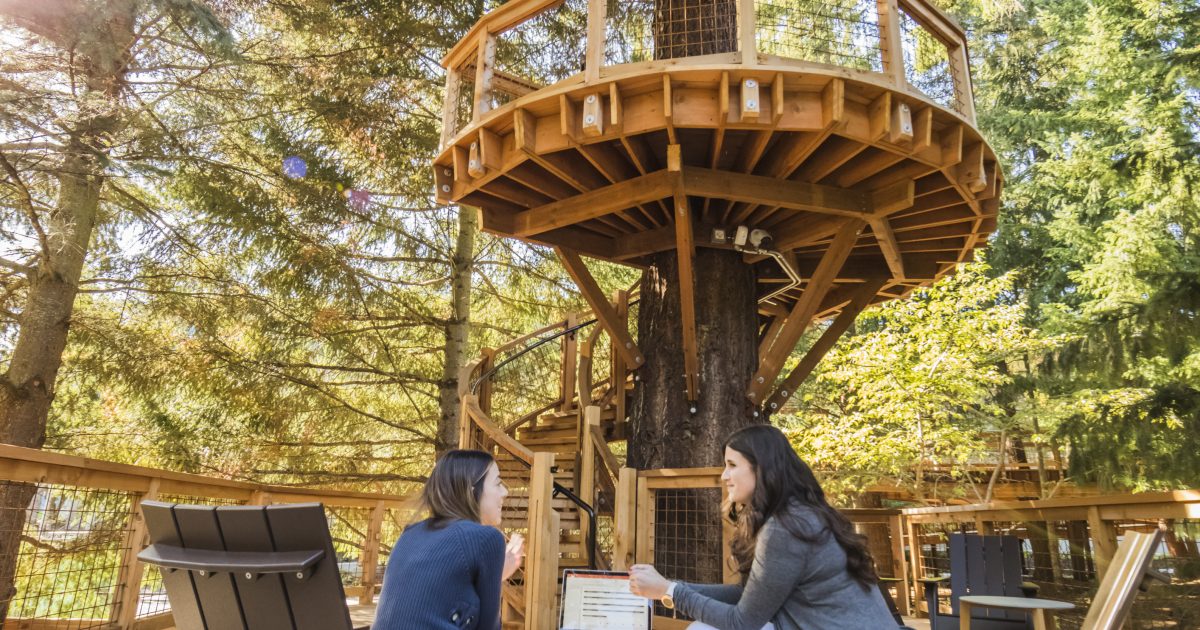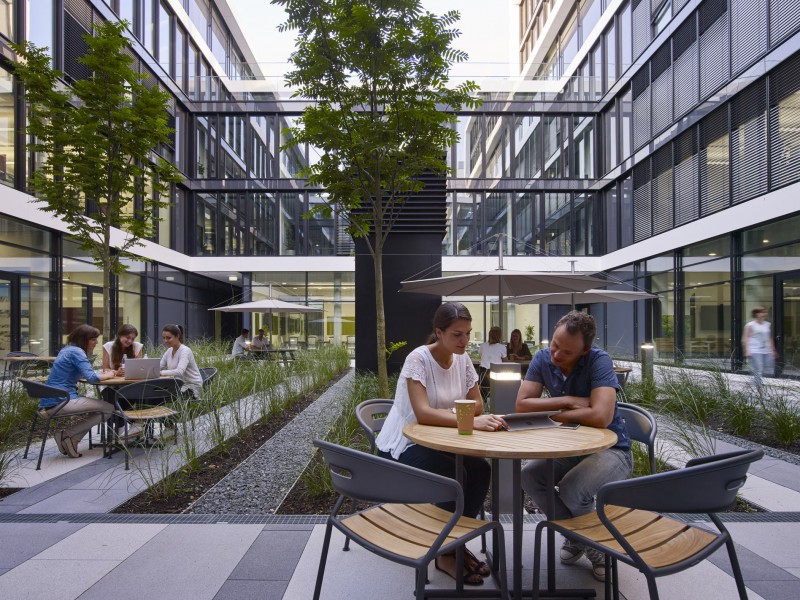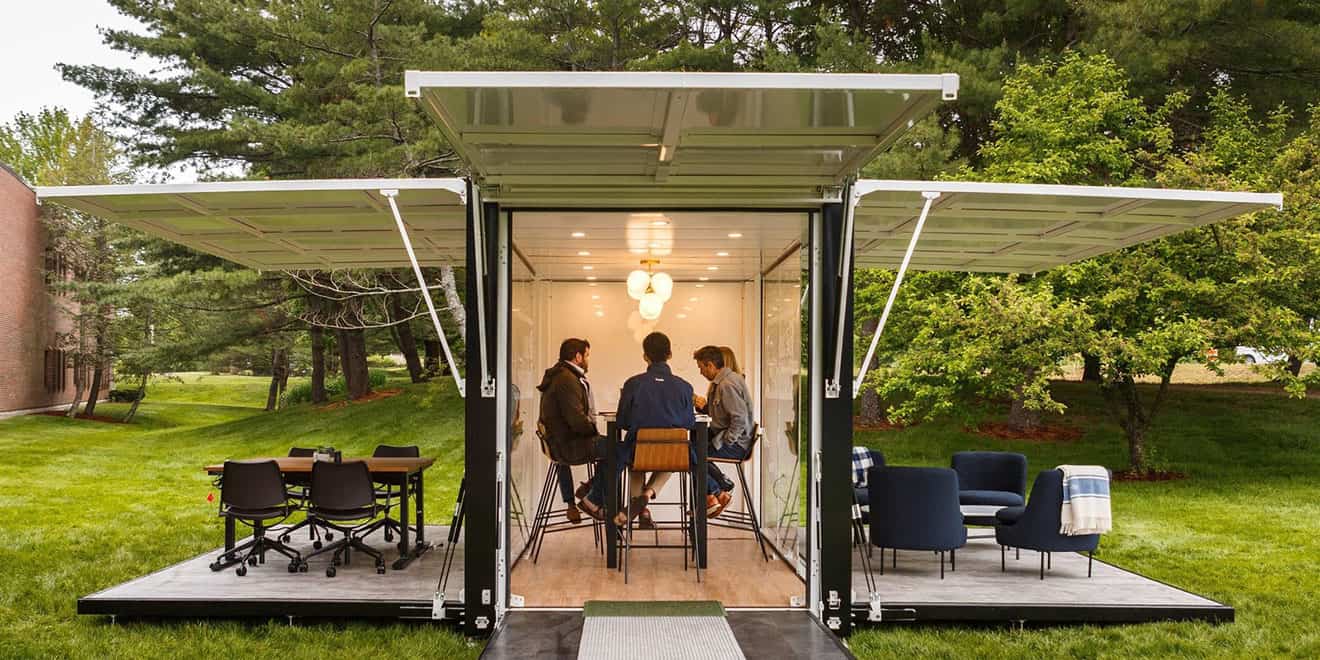Is employee retention, engagement, and happiness important to the success of your business? If so, you may want to find out more about a growing trend that companies such as Amazon, Apple, Google, and Microsoft are utilizing in their work spaces.
Bringing the outdoors in is a long-standing design concept such as trees in shopping malls and offices, the use of natural colors and finishes, outdoor materials such as stone, unfinished wood, and brick. While bringing the outside in is beneficial, it is no substitute for actually getting outdoors. This idea is supported by the biophilia hypothesis, which argues that humans have an innate desire to seek connections with nature. This hypothesis has received increasing acceptance amongst scientists, sociologists, architects, and interior designers – and for good reason. Recent studies have suggested that spending time in nature can lead to increased focus, improved creative thinking and problem solving, and increased happiness. These benefits can have a dramatic impact employee engagement, retention, and productivity.

One great example of biophilic design is The Spheres, in Seattle, Washington. Completed in 2017, The Spheres consist of more than 40,000 plants housed inside three massive glass orbs. Developed by online retail titan, Amazon, The Spheres was designed to provide a creativity-inspiring rainforest greenhouse workspace for their often overworked and desk-bound staff. While the exterior of this design phenomenon appears quite futuristic, the interior looks like an office park that has been consumed by more than 400 plant species – many of them tropical. The top floor of The Spheres includes a brainstorming area, affectionately referred to as the “birds’ nest.”
Concentration & Focus
One benefit of working in an outdoor space is improved employee concentration and focus. Modern offices can be an incredibly distracting environment – especially in open floor plan offices. Ringing phones, noisy conversations, and intrusive instant messages can make it nearly impossible to concentrate. Several recent studies indicate that the distractions of working indoors can have a considerable negative impact on our productivity. In a study conducted by the University of Irvine, California, researchers measured the effects of interruptions on mental acuity. Researchers found that the average office worker is interrupted every 11 minutes, while it takes an average of 25 minutes to bounce back to the original task after an interruption. In a separate study by Carnegie Mellon University, subjects who received an instant message during a cognitive skills test scored 20 percent lower than test subjects who did not receive an instant message. Well-designed outdoor workspace can help to reduce the impact of office distractions and lead to improved performance.

Improved Creativity
Another benefit of working outdoors is improved creativity. Researchers at Stanford University completed a groundbreaking study on the effects of walking for problem solving and idea generation. Study participants who walked on a treadmill indoors experienced a 60 percent increase in creative output, a notable surge in their ability to generate ideas. Once the outdoors was factored into the experiment, creative output soared. Of all the variables tested, walking outside “produced the most novel and highest quality” ideas – 81 percent of participants experienced enhanced creative thinking. As it turns out, the way that most people brainstorm — crammed into conference rooms— might not be the most effective approach.
Problem-Solving
Working outdoors can also provide a powerful boost to our problem-solving skills. A recent study from the University of Utah found that participants solved an average of 47 percent more puzzles after completing a hike than participants who did not go on a hike. While taking a hike in the middle of our workday might not be the most practical option for some, there is evidence that merely walking at a normal, comfortable pace, can help open up the creative pathways in our brains.

Increased Happiness, Engagement & Talent Retention
Most importantly, working outdoors can lead to increased employee happiness, enhanced employee engagement, and improved employee retention. According to a 2018 survey completed by outdoor product retailer L.L. Bean, United States workers between the ages of 22 and 65 spend approximately 95 percent of their time indoors.
- About 87 percent identified themselves as a person who enjoys the outdoors.
- 86 percent of respondents would like to spend more work hours outdoors.
- 74 percent said it would improve their moods.
- 71 percent anticipated reduced stress as a potential benefit.
- 66 percent experienced an increase to their health and wellness.
The more we explore the benefits of spending work hours outdoors, the more we realize the more we see upsides of spending time outside – better productivity, improved focus, enhanced creativity, and even improved health and wellbeing.
Consider Technology & Weather on Functionality
When it comes to designing an outdoor workspace, it is critical to consider the impacts of technology and the weather on functionality. Depending on the geographic location of your outdoor workspace, sunshine, heat, cold, rain, and wind can all necessitate the inclusion of specific components in the design of the space. In warm, sunny climates, it is important to include sunshades, canopies, and/or umbrellas to provide relief from the sun during scorching summer months. Incorporating ceiling fans, mounted fans, and even misters can provide additional relief from the heat. Providing comfort during cold, winter months can typically be accomplished with heat lamps, outdoor fireplaces, and firepits. Incorporating these design elements in your outdoor workspace can also help to create an environment where collaboration thrives.

Technology is also a major consideration when it comes to designing an outdoor workspace. These days, we are all connected 24/7 with our laptops, tablets, cellphones and other wireless devices. Including adequate GFI outlets into the design is essential to ensuring that your employees can keep their batteries charge. WiFi connectivity is another important consideration to ensure that maximum productivity can be achieved in your outdoor workspace. Another design element you might consider including is an outdoor television. Hosting your meetings outdoors can be a great way to enhance employee and client engagement, and the ability to project your screen onto an outdoor television can amplify this impact.
There are a variety of simple ways to incorporate the outdoors in your workspace. Even if it’s not possible to retrofit your current work space to include the outdoors, providing options such as break areas in outdoor common spaces, inviting employees to take a walk or have an option to work outside, or simply bringing in more outdoor elements such as plants and natural daylight – can have a big impact on employees’ concentration and focus, creativity, happiness, productivity, and engagement.



[…] A Stanford University study found that walking outdoors on a treadmill vs walking indoors on one resulted in 81% of the participants having a higher increase in their creative thinking output after being outside. […]
You mention bringing the outside in, but sometimes I’d rather bring the inside outside. lol. Especially when its raining!